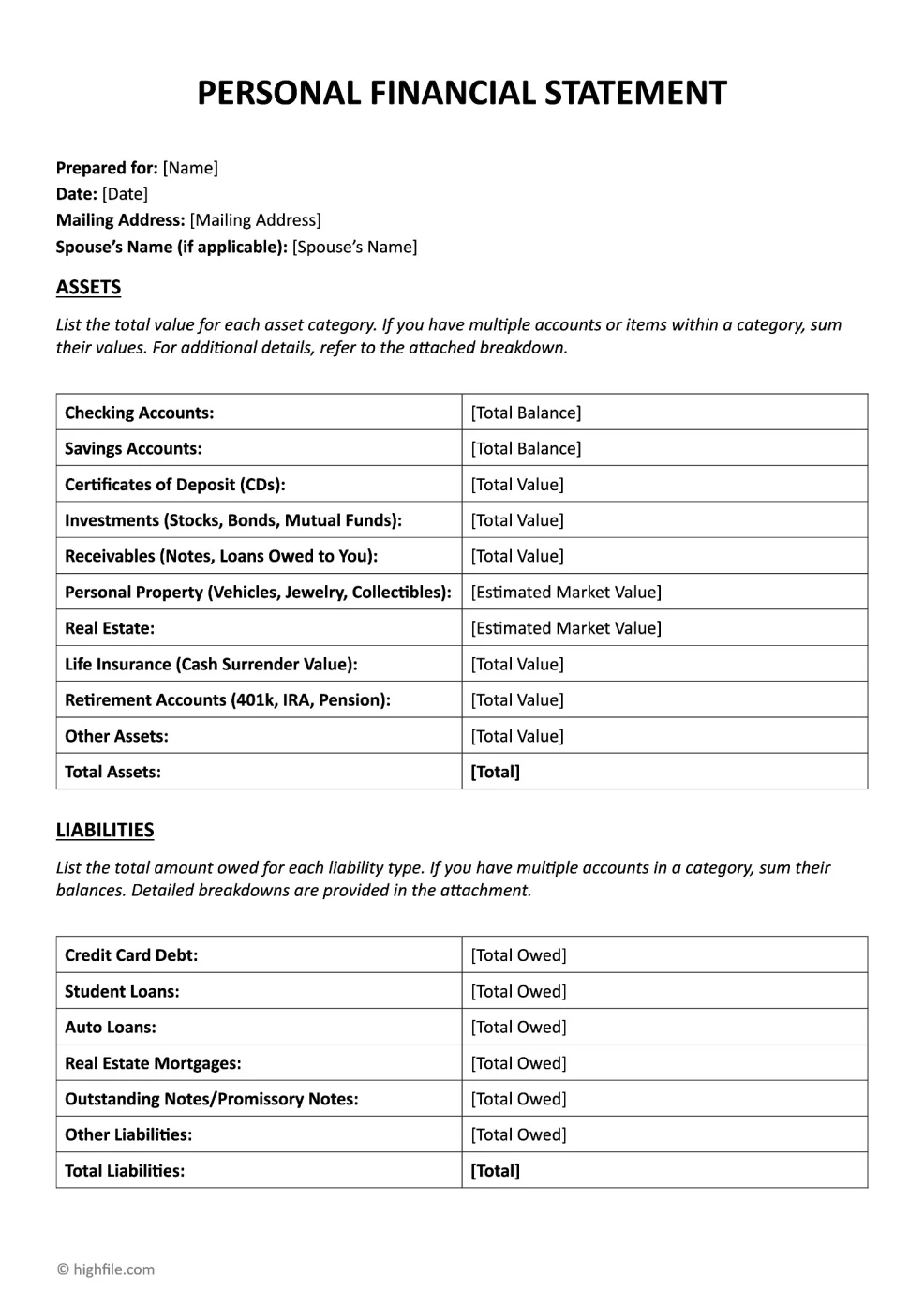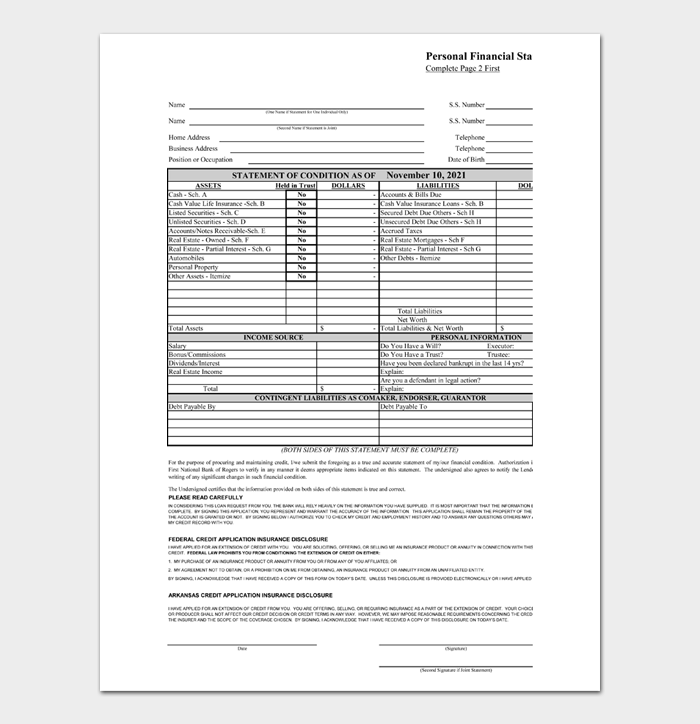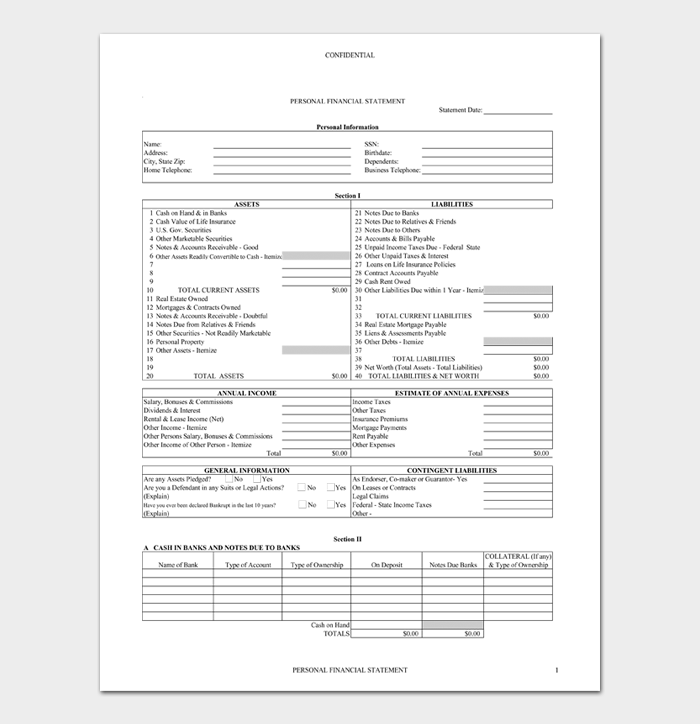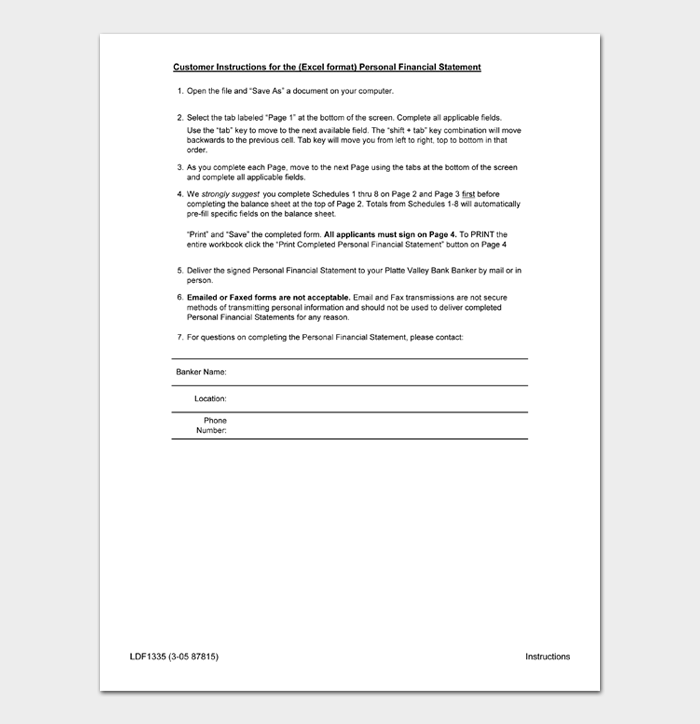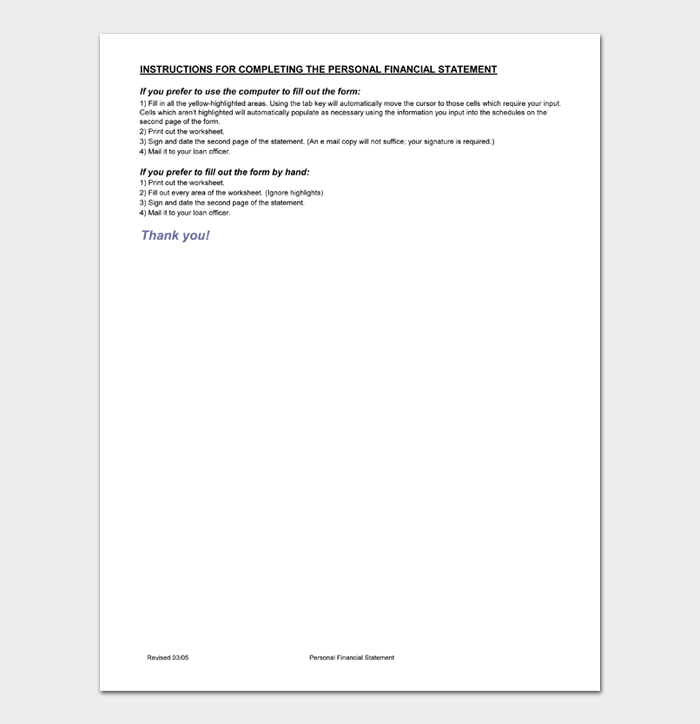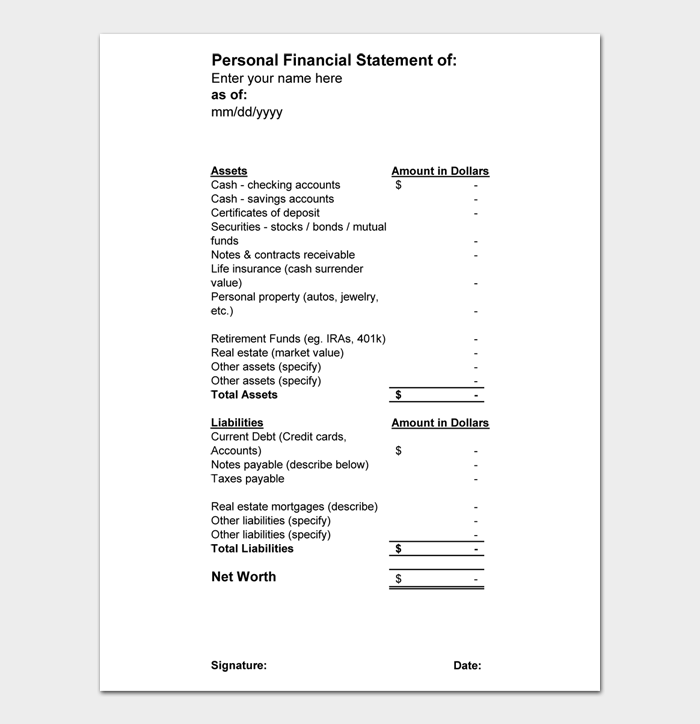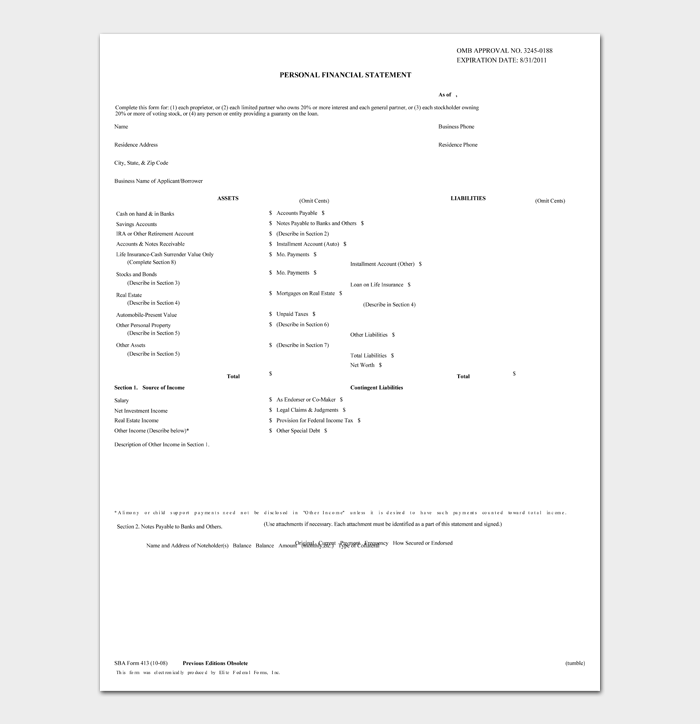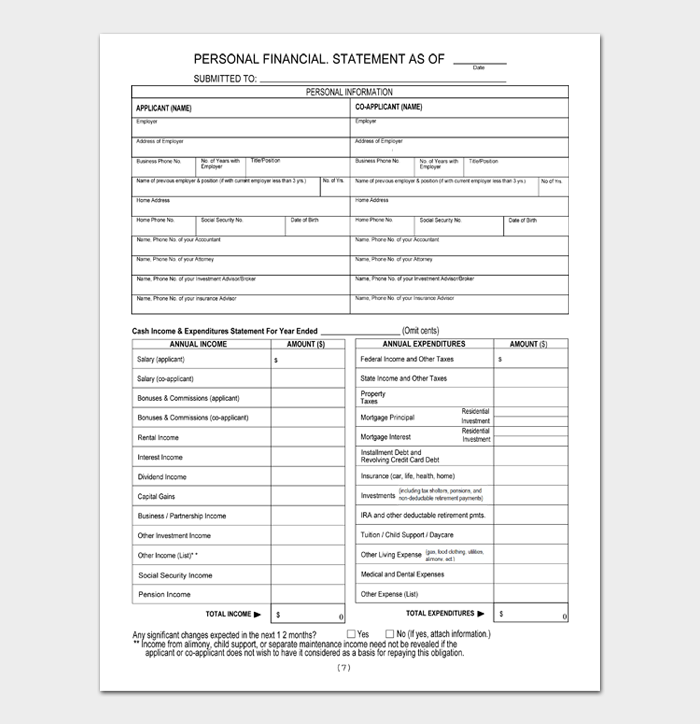A personal financial statement is a formal summary of an individual’s financial position at a specific point in time. It lists total assets, liabilities, and calculates net worth, often required when applying for loans, securing investments, or undergoing financial evaluations. This template includes clearly defined asset and liability sections, a net worth calculation, and space for certification and supporting details.
Personal Financial Statement Template
Personal Financial Statement Template
How to Use This Template
This template is designed to present a clear snapshot of your financial standing. It’s divided into key sections: Assets, Liabilities, Net Worth, and Attachments for additional details.
Header Information

At the top, fill in basic identifying details:
- Prepared for – Your name (or the name of the person this is for)
- Date – The current date or the date of the financial snapshot
- Mailing Address – Your current address
- Spouse’s Name (if applicable) – Add your spouse’s name if you’re including joint finances
Assets Section

List everything you own that has financial value. Each category includes a space for the total value:
- Checking and Savings Accounts – Total balances from all your bank accounts
- Certificates of Deposit (CDs) – Include all active CDs
- Investments – Stocks, bonds, and mutual funds
- Receivables – Any money owed to you (e.g. personal loans you’ve given)
- Personal Property – Items like vehicles, jewelry, or collectibles (use estimated market value)
- Real Estate – Property you own (again, use estimated market value)
- Life Insurance – Cash surrender value only (not death benefit)
- Retirement Accounts – Include 401(k), IRA, pensions
- Other Assets – Anything valuable not listed above
- At the bottom, the Total Assets line automatically sums up all asset categories.
Liabilities Section

List everything you owe. Each row covers a different debt category:
- Credit Card Debt – Total current outstanding balances
- Student Loans – Include both federal and private
- Auto Loans – Any loans taken for vehicles
- Real Estate Mortgages – Total balance due on any home or land loans
- Outstanding Notes/Promissory Notes – Any documented money you owe
- Other Liabilities – Any other debts not covered above
- The Total Liabilities line should be the sum of all these categories.
Net Worth

Calculate as:
Total Assets – Total Liabilities = Net Worth
This shows your current financial position in a single number.
Certification

You must sign and date this section to confirm that the information is accurate and complete. This is especially important when submitting to financial institutions or lenders.
Attachments (Optional but Recommended)

Use these for backup documentation:
- Attachment A: Asset Details – List institutions, account numbers (optional), and balances for each asset
- Attachment B: Liability Details – Include lender names, descriptions, and amounts owed for each liability
These attachments support the numbers shown in the main sections and add credibility when needed for official purposes.
What is a Personal Financial Statement?
A personal financial statement is a document that outlines an individual’s financial position at a specific point in time. It lists assets, liabilities, and calculates net worth. This statement is often used by banks, lenders, or investors to assess a person’s financial stability or creditworthiness when reviewing applications for loans, mortgages, or other types of financing.
Personal Financial Statement Examples
#1
#2
#3
#4
#5
#6
#7
#8
#9
#10
#11
#12
#13
#14
#15
#16
#17
How to Prepare a Personal Financial Statement
Preparing a personal financial statement involves organizing key financial details to reflect your current financial position. Here are the general steps:
- Set up a spreadsheet or use a template. Begin by creating separate sections for your assets and liabilities. You can start with either, but both sections should be included. You’ll also need a space to calculate your net worth by subtracting total liabilities from total assets.
- List your assets. Only include items you legally own. Common assets include real estate, vehicles, retirement accounts, savings, checking accounts, investments, life insurance (cash value), and valuable personal property like collectibles or fine art. Avoid listing rented properties or low-value items. Assign an estimated value to each asset.
- List your liabilities. Liabilities are financial obligations or debts. These might include credit card balances, mortgages, student loans, personal loans, unpaid taxes, or legal judgments. List each liability along with the amount you owe.
- Calculate totals. Add up the total value of your assets and liabilities. If you’re using a spreadsheet, apply a formula to simplify the calculation process.
- Determine your net worth. Subtract total liabilities from total assets to find your net worth. This number represents your financial standing at that moment.
- Include income (if applicable). In some cases, especially when applying for loans or credit, you may also include details about your income. This helps give a fuller picture of your financial capacity.
Legal Considerations
The personal financial statement entails several legal considerations compared to a corporate document or form. Since this document should create an accurate image of the financial status, you need to take the entire process seriously, just as you take other legal documents seriously. Make sure that your personal financial statement includes your personal property, rented items, and business-related liabilities and assets
Personal financial statements and audits
Auditing can only happen if the court or IRS asks for your financial documents since they do not find you trustworthy about your financial status. The auditing process can be pretty stressful because you might need to hire an accountant or attorney to help you out, which can be an additional cost on your end. Remember, financial dishonesty can make you face criminal or civil charges, resulting in jail terms or fines. Furthermore, IRS or the court can order you to stop all your businesses.
So, what number of personal financial statements do you need?
Statistics from the small business administration guidelines state that personal financial statements need to be accomplished by each loan guarantor. Besides each stockholder featuring around 20% of voting stock and each limited partner with 20% or a large percentage of the business, every general partner and the proprietor must complete the personal financial statement. Creating a personal financial statement for the parties mentioned above might seem hectic, but it can be quick if you use a simple financial statement that features a similar format.
FAQs
Due to the advanced technology, you can use computer software to prepare your financial statements. However, if you are preparing for a third party, like bankers, they might request that their financial statement be created by a certified public accountant or a professional accountant.
The two types of the personal financial statement include:
– A personal balance sheet
– A personal cash flow statement
There are several purposes of financial statements. They include:
– Offering information about financial status within a specific time
– Generate data that you can utilize to apply for credit or prepare your tax forms
– To keep you updated on the financial activities
– It determines your development towards your entire financial goals
– Reports the current financial position, which must entail your assets and liabilities
Final Thoughts
A personal financial statement is an important document when applying for a business loan or other types of financing. It gives lenders a clear picture of your financial standing and your ability to manage funds. Before approaching any financing source, make sure your financial statement is complete, accurate, and up to date.
